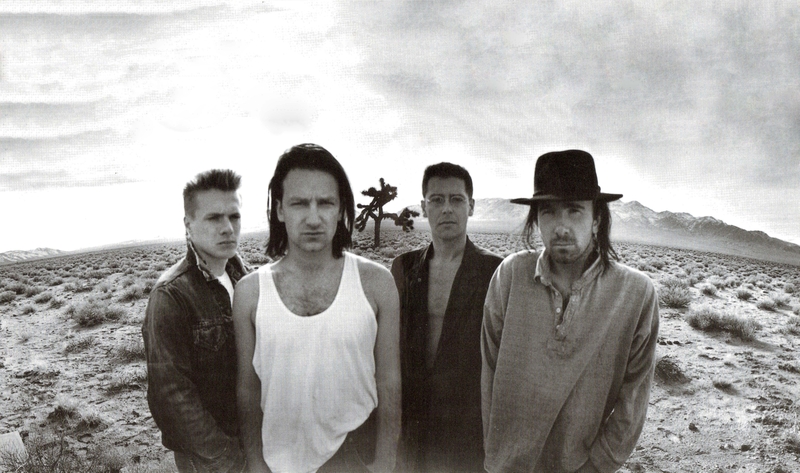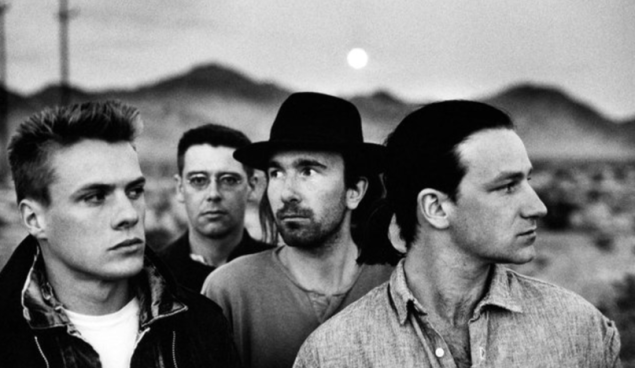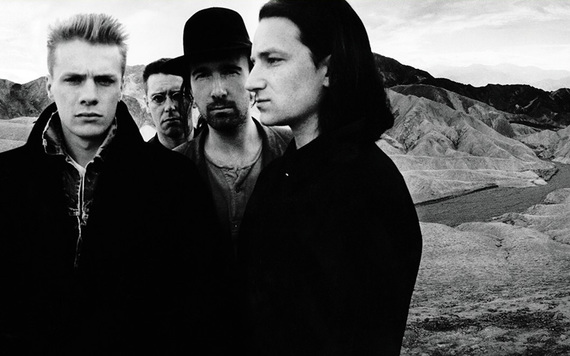
Alternately ecstatic and underwhelming, historic and histrionic, powerful and vague, The Joshua Tree is half a masterpiece.
U2’s The Joshua Tree turns 30 this week, an event to be celebrated by a tour, a series of commemorative plates from the Franklin Mint, and a newly discovered Irish moss to be named Polytrichum Piliferum Joshuam.[i]
U2’s fifth studio album is a testimony to the churning, night-purple planetarium of starry majesty they could harness and wrap around the simplest frames, while at the same time exposing the band’s distressing and consistent habit of turning on autopilot halfway through an album.
The Joshua Tree is also a masterclass in the act of transparent but effective appropriation, something U2 have always been very, very good at. Like David Bowie (or Led Zeppelin and R.E.M.), the sheer weight of U2’s personality and charismatic energy allows them to get away with the most basic thievery: in their hands, it doesn’t feel like plagiarism, but like a redistribution of deserving and lesser-known art to the masses.
First, let’s talk about an absolutely integral aspect of The Joshua Tree: we’ll call this “The Phone Book Phenomenon.”
This is one of the truly remarkable things about The Joshua Tree—if you just listen to the first side, you’re fairly convinced that you’re hearing one of the greatest classic rock albums of all time; but once you hit the second side (beginning with track six, “Red Hill Mining Town”), U2 are playing the phone book.
Which is to say that Bono could sing the phone book or a list of Shipping Container Weights and Dimensions (“20-foot open-top container: Nineteen feet five inches by seven foot eight inches…Forty-foot flat-rack container: Thirty-eight feet nine and one-quarter inches by seven feet eight inches…”) and make it sound like the classiest, deepest text in the world.
Bono’s rich, cracking, soaring voice, alternately hushed and emphatic, orating and operatic, can invest the thinnest material with drama, grace, and meaning. And as for the rest of the band, even when the U2 ensemble sound machine is on autopilot, they present completely reasonable and entertaining high-end hold music.
Dammit, how can we trust a band so willing to go on autopilot?
Yet we do, because when U2 are good, they are so damn good. They are the shiniest and most helium-inflated post-punk band that ever lived, so it’s generally pretty easy to overlook how frequently they just bloody phone it in.
With the exception of just one song, Side Two of The Joshua Tree is so underwhelming that one wonders if it’s intentional: As U2 say farewell to the era of extraordinary ensemble playing that made them the last true great classic rock band, perhaps they’re saying, “The machine is beautiful when it’s humming, isn’t she? It makes little difference what song is being hummed, and it’s time to say farewell to this machine.”

Now, Side One of The Joshua Tree is an entirely different story, and if we view The Joshua Tree only through the prism of its first five songs—and I believe this is precisely what most of the world does—even the most cynical amongst us would be convinced you are listening to one of the best rock albums of all time.
For the first 24 minutes of The Joshua Tree, U2 transcend their influences and their corny aspirations to holiness and majesty, and actually becomes the band of their dreams (and our dreams). This mixture of mathematics and ambience, superficial gimmicks to reach the heart and moments of genuine transcendence, almost comically transparent “appropriations” from other artists and holy bows of tribute, is like the greatest work of the Beatles or Floyd: Accessible to the masses yet full of a genuine edge.
It starts out mysteriously, ominously, then joyously, ecstatically, wrapping us in a cocoon of ticking guitars and rattling Ramones-meets-Wobble bass and KrautEno ambience and stadium huzzahs and intimate bedtime whispers.
The first side of The Joshua Tree makes us its captive, and this is no accident; it is a precise scientific effect. With seemingly effortless precision, the repeat-effects of the Edge’s guitar, the bpm of the drums, and the verb on the vocals mathematically match to create maximum engagement with the listener.
The deeply psycho-acoustic effect of The Joshua Tree is one of its great secrets, and it is one of the best examples of commercial rock utilizing psycho-rhythmic entrainment. Much of The Joshua Tree is a ticking clock, a mind-bomb scientifically designed to alert and seduce you.
[youtube https://www.youtube.com/watch?v=XmSdTa9kaiQ&w=560&h=315]
“Where the Streets Have No Name,” “I Still Haven’t Found What I’m Looking For,” and “With or Without You” comprise what could be the best three-song start to any mainstream rock album, ever.
The first two espouse a deeply scientific approach to emotionally desperate, musically simple, and conceptually complex power rock songs, and the third track remains an engaging miracle, a mega rock anthem of such understated simplicity that it is as uncomplicated as the Ramones covering Suicide and as intimate and intense as a Young Marble Giants song.
It’s worth noting that “With or Without You” has, like many U2 songs, a curious and obvious antecedent. In many ways, the Talking Heads’ Eno-produced “Once In A Lifetime” (1980) is the beta version of “With or Without You.”
Don’t believe me? Give “Once In A Lifetime” a listen.
[youtube https://www.youtube.com/watch?v=I1wg1DNHbNU&w=560&h=315]
Uh-huh, there it is, that twinkly psycho-arpeggio faux-Terry Riley-ambience into a heartbeat of a dead-simple chord movement and an almost garage-rock-via-heaven simplicity. It’s fairly clear when U2 and Eno went into the studio, U2 pointed to the earlier Talking Heads song and said, yeh, gimme one of those.
Regardless, I am hard pressed to think of another rock song of the stature and success of “With or Without You” that is based on a four-measure repeated, unchanging chord sequence (even “Sweet Jane” and “Blitzkrieg Bop” have distinct bridges with chord changes that differ from the verse and chorus sequence). “With or Without You” is a miracle, one of the artiest mega-pop songs ever released, and it still stuns when it comes over the radio.
True, the bass line of “With or Without You” bears a fairly strong resemblance to Flipper’s “Ha Ha Ha,” and although it’s very possible that U2 could have encountered that extraordinary and influential nosebleed of a song during their early days dragging their pale Irish asses around American college radio stations, I suspect this may be just a coincidence.
However, dear friends, the resemblance of “I Still Haven’t Found What I’m Looking For” to another extant song is most definitely not a coincidence, and this provides a terrific clue to the album’s message and mission statement.
[youtube https://www.youtube.com/watch?v=e3-5YC_oHjE&w=560&h=315]
Lyrically/conceptually, The Joshua Tree is largely built around the idea that U2 are giving us their impression of the United States. U2’s United States is full of red rocks and white deserts and ageless mesas crossed by the man-made ley lines that rust-red boxcars roll across; it’s an echoing landscape of loneliness and potential.
When we examine “I Still Haven’t Found What I’m Looking For,” we find the map for this trip. The song has a melody lifted, virtually intact, from the old bluegrass/gospel standard, “I Am A Pilgrim” (the lyrical drift is similar, too); in fact, it’s so similar that when I first heard the song, I thought it was a cover.
Although many artists have performed “I Am A Pilgrim” through the years, perhaps the best-known version is on the Byrds’ country’n’mushrooms opus, Sweetheart of the Rodeo. Recall that Sweetheart of the Rodeo prominently features pioneering country rocker Gram Parsons; Parsons is famously associated with the aura-filled California desert town where he died, Joshua Tree. A-ha! We have come full circle! Do the Mu!
So basically anyone could figure out that U2 were listening to Sweetheart of the Rodeo and Gram Parsons when they conceptualized and wrote The Joshua Tree, and were seeking their own post-Krautrock evocation of a quirky Route 66-via-Laurel Canyon fantasy.[ii]
Now, that’s a lot to chew over, though it all makes sense if you follow the road signs (from the California desert to Ireland via Dusseldorf and then back to the desert); but with all that conceptual baggage, is it any surprise that the album pretty much falls apart on Side Two?
Let’s finish up Side One first, which ends with “Running to Stand Still,” a damn fine song, and a particularly strong and effective example of something we keep coming across on The Joshua Tree (and throughout the band’s catalog): U2’s ability to adapt a trademark style of another band—even another specific song—and transform it into something very much their own.[iii]
On “Running to Stand Still” U2 are paying homage to not one but three aspects of the Velvet Underground and Lou Reed: “Running to Stand Still” adapts the chord changes from “Waiting for the Man,” the gentle and persuasive ambient style of the third (self-titled) Velvet Underground album, and the melody of Lou Reed’s “Satellite of Love.” It says a great, great deal about U2 that not only do they have the balls to do this, but they also actually turn all this larceny into an emotive, effective, and truly resonant track.

Side Two of The Joshua Tree is almost like a separate album: restrained, underwhelming, and made up of observational postcards (and not epic letters). This is typified by the hokey and transparent “Red Hill Mining Town,” which seems to announce that, once again, U2 have front-loaded an LP and are going to make a precipitous dip on Side Two (they had been evidencing this trait ever since their first full-length, Boy).
Likewise, “In God’s Country” is a lazy, paper-thin song wrapped in the standard pieces of U2’s arsenal: the precise 16-beats-per-bar strum that U2 borrowed from Orange Juice (and “What Goes On”-era Velvet Underground), combined with some “heavy” lyrics about America (or maybe, oh I don’t know, Jerusalem), and the echoing guitar originally appropriated from the Skids but perfected by Dan Lanois, Michael Brook, Steve Lillywhite, and Eno. It’s U2 by the numbers, but it says a lot that it’s still fairly fun and diverting to listen to.
There’s also virtually nothing to “Trip Through Your Wires.” It’s barely a B-side, elevated to “meaning” because of its presence on this famous album. To be frank, it’s an excellent example of how The Joshua Tree shouldn’t necessarily be considered an all-time great album, because all-time great albums don’t have this many moments where the band are just totally effing coasting.
Perhaps the oddest track on Side Two is “Exit.” For the third time on The Joshua Tree, U2 are attempting a blatant and easily traceable appropriation: “Exit” owes a great, great deal to “Land” from Patti Smith’s Horses album (though it lacks the startling wit and originality of “Land”).
The only honestly great track on the entire second side is the album’s closer, “Mothers of the Disappeared.”
“Mothers of the Disappeared” combines a folk-ish melody with an ambience heavily influenced by the glowing, tick-tocking Krautrock of Roedelius, Harmonia, and Cluster (in fact, the rhythmic basis of “Mothers of the Disappeared” is so Cluster-like as to be an unmistakable homage; note Cluster’s “Sowiesoso,” from 1976, or 1978’s After The Heat, the collaboration between Eno and Cluster’s Hans Joachim Roedelius and Dieter Moebius).
“Mothers of the Disappeared” is also a very important track. It points to U2’s future as a band who were to engage Krautrock (and the European disco influences that spun off of Krautrock) as much as they had earlier engaged guitar-based post-punk. I think you can make the case that this vein of U2’s life begins with “Mothers of the Disappeared.”
I think the biggest surprise about The Joshua Tree is that even considering the high quality of Side One (and the nearly historic effect of the first three songs), 1984’s The Unforgettable Fire is a better album.
[youtube https://www.youtube.com/watch?v=LHcP4MWABGY?list=PLv1513VPVnzShEUhAQrpQ9D8aIajuii6h&w=560&h=315]
The Unforgettable Fire is a triumph of ensemble playing, perhaps the last flare of U2’s explosive, inventive years as a conventionally unconventional rock band, listening closely to each other while still sounding urgent, frantic, and deeply excited. The Joshua Tree, although it is clearly recognizable as an “early” U2 album, sounds like a studio creation, and not a recording of an exciting, original, and explosive band.
The Unforgettable Fire is a great album. The Joshua Tree is half of a great album.
[i] Not all of these things may be true.
[ii] Mind you, when it comes to this sort of thing—big-reverb, post-Lanois evocations of the holy emptiness of the desert seen through the eyes of a city-wise musician—as effective as The Joshua Tree is, I’d have to say I (vastly) prefer Chris Whitley’s Malcolm Burn-produced Living With The Law (1991), which is basically the go-to masterpiece for this kind of sandy, burnt, emotionally loaded ambience; or, more recently, the stunning Tone Poet, Vol. 3 by Derwood Andrews (2016), which sounds like the high desert under a moonlight sky virtually playing itself (this album deserves a lot more attention, and I’ll write about it in depth in the future).
[iii] U2’s debut, Boy, contained no less then three (very) easily traced “appropriations.” Two of these—“An Cat Dubh” (which contained immediately recognizable elements from two different Wire songs) and “Out of Control” (which bore a striking resemblance to the Skids’ “Of One Skin”) were so clear that it’s a wonder there wasn’t litigation. Henceforth, U2 did a slightly better job at dusting up and disguising their penchant for borrowing melodies and riffs from other artists.

